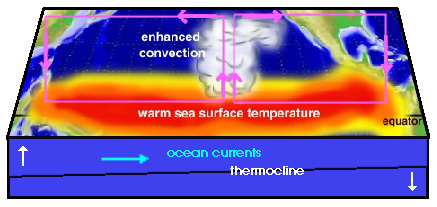


The warm waters of El Niño are a part of the event called the El Niño Southern Oscillation, which encompasses the central Pacific region. Normally a warm pool of ocean water builds up in the western equatorial Pacific Ocean, kept at bay from the trade winds, blowing east to west. The easterly trade winds are driven by a surface pressure pattern of lower pressure in the western Pacific and higher pressure in the eastern Pacific. When this pressure pattern weakens, the trade winds slacken or even reverse! This causes the warmer water to propagate eastward via Kelvin Waves.
The warmer water causes the thermocline to sink, which causes the upwelling to occur at a deeper level in the ocean. This is critical at the western coasts of the Americas since without the upwelling of nutrient rich bottom water the fish population is greatly reduced. Convection is driven by the warming of the surface air over the warm water; as the water propagates eastward, so does the heavy rains caused by the convection. The shift in the convection causes a change in the global weather pattern, causing drought, floods, storms, and other weather anomalies in many area of the world.
Also part of the El Niño Southern Oscillation is its cold counterpart, La Niña, also called the cold event or El Viejo. It is marked by cold water propagating to the west and strong trade winds. The weather patterns associated with La Niña are not necessarily equal and opposite to the El Niño weather patterns.
The following graphic shows the sea surface temperature distribution in the Pacific Ocean for an El Niño.
Dec. 1997 |

|
 |